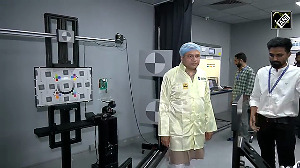When it entered India in February 1996, DaimlerChrysler (then Mercedes-Benz) was the first premium car manufacturer to drive on Indian roads. Nine years later, seven international luxury car brands -- from the sporty Porsche to the regal Rolls-Royce -- are fighting for space in the garages of India's rich and famous. But are there enough buyers at the luxury car mart?
There's a big question mark on that. Analysts estimate the Indian premium car market at less than 2,500 cars a year, growing at about 15 per cent a year. Take the smaller and less expensive Mercedes-Benz C-Class out of that list, and the number shrinks to 1,700 units -- less than 2 per cent of the 1.07 million unit passenger car market (source: SIAM).
Luxury at a glance
|
Brand |
Price (Rs) |
| Audi | 40-70 lakh |
| Bentley | 41.7-2.5 crore |
| BMW | 45-60 lakh |
| Rolls-Royce | 3 crore |
| DaimlerChrysler Marcedes Benz Maybach |
24.2-98 lakh 5.5 crore |
| Porsche | 45 lakh onwards |
| Jaguar | 80 lakh |
Considering the cheapest car in the luxury segment (the Mercedes-Benz C 200) costs Rs 24.2 lakh (Rs 2.4 million), going all the way up to Rs 5.5 crore (Maybach), are there enough buyers for these hot wheels? What strategies are the big seven going to adopt in the Indian market? And are there any lessons to be picked up along the way from the Mercedes experience?
Bring on the buyers
Let's set the record straight. There are enough people in India who can afford these high-sticker cars. The 2004 report on the Indian economy by the National Council of Applied Economic Research (NCAER) says that by next year India will have 53,000 households that earn over Rs 1 crore (Rs 10 million) a year. That's up from just 20,000 such households five years ago. So clearly, the list of prospective buyers for premium cars is growing.
Besides, the premium car makers recognise that in India they can't do 0 to 60 in 8 seconds: they're ready for a long haul. DaimlerChrysler (which makes both Mercedes and Maybach) sold 1,815 cars last year, up from 1, 581 the previous year. By 2010, it hopes to sell 4,000 units a year.
Audi's adopted a similar, long-term view. Launched in mid-2004, the German carmaker is aiming to sell just 100-150 units of its A8 and A6 (which compare to the Merc S-Class and the E-Class respectively) in the first year. That places it at a low No. 55 on the company's worldwide sales charts. But Michael Weber, Audi's country manager for India, is convinced of the potential here.
"We think to be here in time is important for positioning the brand," he says. Audi estimates the luxury car market will cross 5,000 units this year -- a huge overestimate according to many analysts, even accounting for imports like Hyundai Tucson and Toyota Land Cruiser. Going by that, it could still take 10 years before every Indian crorepati owns a luxury car. Of course, the number of Rs 1 crore earning households would have increased by then.
A bumpy ride
Has DaimlerChrysler given competitors a ready reckoner to crack the Indian market? When it entered India, everything was in its favour -- from a tremendous brand equity to a virgin market. At the time, the Indian car market was just revving up.
The highest priced cars on Indian roads were Daewoo Cielo (Rs 500,000) and the Peugeot 309 (Rs 500,000-700,000); arch rival BMW was the only other premium car available here, but only through a lone dealership in Thane. In contrast, the first Mercedes-Benz manufacturing unit outside Germany came up at Pune, with investments of close to Rs 600 crore (Rs 6 billion).
But Mercedes' first few years in India were bumpy. From 1,800-odd cars sold in 1996, sales plunged to 734 units in 1999. The trouble -- premium car brands would do well to pay attention -- lay in the product portfolio and the dealer network. Or rather, the lack of both.
Mercedes' opening gambit comprised the E220 and E250 Diesel models, part of the W124 series. Both were dated: the new E Class W210 series was already ready to roll out in Germany. And Indian consumers knew that -- remember, the luxury car buyer is inevitably well-informed about global developments. In their opinion, the W124 was a hand-me-down.
From the company's point of view, the choice of model made sense. "The car was popular globally, hence we were confident that it might work in India," says Suhas Kadlaskar, director for corporate affairs and finance, DaimlerChrysler India.
The E-Class is longer and wider than the C-Class saloon -- important attributes for prospective premium car buyers. It was also pricier: Rs 23-25 lakh (Rs 2.3-2.5 million), compared to the Rs 15-16 lakh (Rs 1.5-Rs 1.6 million) the C-Class would cost. And analysts point out that low-volume models give companies time to set up the sales and service network.
But Mercedes didn't take advantage of that opportunity. Until 1998, the company served customers directly through offices in Delhi, Mumbai and Chennai. It did tie up with the Tata Group to set up the Concorde chain of exclusive showrooms, but that went off track, too. Meanwhile, sales moved to low gear.
The lessons: get the latest models and offer customers variety. In 1997, Mercedes launched the W210 series, followed by the S-Class in 2000; and the C-Class in 2001. Imported CBUs (completely built units) of sports and luxury convertibles came in 2002, while the super luxury brand, the Maybach, hit Indian roads in 2004.
At present, DaimlerChrysler has 12 models for sale in India. Kadlaskar says the variety helps in upselling to existing customers: about 70 per cent of Mercedes buyers in India are repeat customers.
Bring it in
If DaimlerChrysler set up a plant here, other premium car brands are encouraging imports. For some, even setting up an assembly facility did not make sense.
For instance, Rolls-Royce and Bentley churn out just 3,000-5,000 cars every year from the plant in the UK; Porsche makes just 70,000 cars a year. Audi, too, has a conservative approach. Weber says Audi's future strategy depends on the market response.
"If we can achieve economies of scale we might consider manufacturing in India. Till then, importing CBUs is the most appropriate option," he points out.
Of course, CBUs carry their own set of problems, the biggest being the waiting period: from order to delivery can take anywhere from two to seven months. DaimlerChrysler executives believe this gives them an edge: the E-Class, C-Class and the S-Class are put together in India ("made by Mercedes in India"). That's not a widely held view, though. Satya Prakash Bagla, Bentley's dealer in Delhi, argues that customers will wait for exclusivity and customisation.
But even Bentley has picked up a tip or two. Soon after the powerful, two-door GT was launched in India, Bentley realised it needed a four-door luxury limo -- what Mercedes has -- to get the serious numbers in India. The Flying Spur, which was launched last week, is just that, a four-door GT that is less expensive -- Rs 70 lakh (Rs 7 million) less! -- compared to the old-world Continentals.
Porsche, which entered India in 2004, had a similar experience. Bagla -- whose Exclusive Motors also handles the Delhi dealership for Porsche -- says it is targeting a younger customer for the Boxster 911 and the sports utility vehicle, Cayenne.
Dealers say sales of the Cayenne are already picking up speed, compared to the 911, and auto analysts aren't surprised: the state of Indian roads don't do justice to a sports coupe (like the 911). Says an expert: "Porsche sensibly waited for the international launch of the Cayenne before entering India."
Serve the rich
Customers paying top dollar for fancy cars expect fancy service too. Premium car makers will find that while it's easy to serve the metro car buyer, those in the hinterland are a different proposition. And there are plenty of them there. A peek into the NCAER report only emphasises the need for an efficient service network: one in four households that earn over Rs 1 crore a year is based in small towns and rural areas.
DaimlerChrysler's found that out for itself: demand for the Rs 65-lakh (Rs 6.5 million) S-Class comes from such unlikely places as Ludhiana and Bhiwandi. From 15 service centres in 2000, it now has 22 dealer.
The others, though, are still sticking to Delhi, Mumbai and (in some cases) Bangalore. Audi will open its third sales outlet in Bangalore by the end of the year; BMW is already present there. An analyst says brands like Toyota reach where the Audis and BMWs have not yet cast their net.
He adds, "An established sales and service network can make a real difference. Which is why the Toyota Camry and Land Cruiser eat into the sales of others."
Bentley, though, has found a way out that also works as a subtle brand builder: at Rs 1.7 crore (Rs 17 million) a car, it does not -- should not -- need much after-sales support. So, when it does, Bentley simply sends the mechanic over for a house call.
That's something Mercedes and the other players in the luxury market could emulate. Perhaps the learning process could work both ways.
On a roll
Back in the 1930s, Bentley and Rolls-Royce competed with each other -- Bentley made sporty cars that won races at Le Mans and the Rolls was the luxury car of the rich and royal. Then in 1938, Rolls-Royce bought over cash-strapped Bentley and owned the company until 1999.
During this period, Bentleys -- even the Continental, which was launched in India -- were actually Rolls-Royces under the hood, since they shared most of the mechanicals. As a result, the car did not have a distinct personality. In 1999, BMW and Volkswagen engaged in a fierce bidding battle for Rolls-Royce and Bentley.
After it was bought over by Volkswagen, the new series of Bentley cars started building a presence on the roads. The Flying Spur, which was launched last week in India, is one such example.
BMW lost out on the bid for the Rolls-Royce and Bentley car plant, but did land the Rolls-Royce brand. BMW set up a greenfield facility in UK to build an all new Rolls from scratch -- the Phantom. The Allies may have won the World War, but the Germans won the battle for the cars.








 © 2025
© 2025